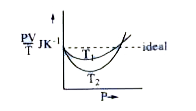Answer the questions on the basis of given information

A molecule of gas collides with the wall of a container elastically.
The expression of pressure due to the collision of molecules of velocity vxisSolution in Telugu
nmv2
nmv2x
nmvx
12nmv2x
The correct Answer is:B
Step by step video, text & image solution for Answer the questions on the basis of given information A molecule of gas collides with the wall of a container elastically. The expression of pressure due to the collision of molecules of velocity v_(x)is by Physics experts to help you in doubts & scoring excellent marks in Class 11 exams.
Related Playlists
- BOOK - AAKASH SERIESCHAPTER - KINETIC THEORY OF GASESEXERCISE - EXERCISE-3(Kinetic Theory of an ideal gas)4videos
KINETIC THEORY OF GASES
- BOOK - AAKASH SERIESCHAPTER - KINETIC THEORY OF GASESEXERCISE - EXERCISE-3(Various speed of gas molecules)10videos
KINETIC THEORY OF GASES
- BOOK - AAKASH SERIESCHAPTER - KINETIC THEORY OF GASESEXERCISE - EXERCISE-IB(Theoretical Questions)29videos
KINETIC THEORY OF GASES
- BOOK - AAKASH SERIESCHAPTER - KINEMATICSEXERCISE - ADDITIONAL PRACTICE EXERCISE (PRACTICE SHEET (ADVANCED)) (Integer Type Questions)12videos
KINEMATICS
- BOOK - AAKASH SERIESCHAPTER - LAWS OF MOTIONEXERCISE - PRACTICE EXERCISE108videos
LAWS OF MOTION
Similar Questions
Given is the graph between PV/T and P for 1 gm of oxygen gas at two different temperature T1 and T2 (Given:Density of oxygen=1.429kg/m3).The value of PV/T at the point A and the relation between T1 and T2 and respectively
 01:55View Solution
01:55View SolutionFour particles have speed 2,3,4 and 5 cm/s respectively. Their rms speed is :
01:50View Solution(A): The total translational kinetic energy of all the molecules of a given mass of an ideal gas is 1.5 times the product of its pressure and its volume.
(R): The molecules of a gas collide with each other and the velocities of the molecules change due to the collision.01:14View SolutionThree particles start from origin at the same time: one with velocity v1 along positive x - axis, the second along the positive y-axis with a velocity v2 and the third along the line y=x with such a speed that all the three always stay in a straight line, then the velocity of the third particle is √kV1V2(V1+V2).
01:19View SolutionA force of 50 N acts on a body of mass 10 kg at rest. Its velocity after 5 seconds if the same force acts, is
02:36View SolutionThe pressure exterted on the walls of the container by a gas is due to the fact that the gas molecules
02:14View SolutionA molecule of mass 'm' collide with a wall of container in normal direction with a velocity c. if the collision is perfectly elastic, then the change in momentum of the molcules is
02:29View SolutionThe pressure exerted on the walls of gas container is due to_________imparted by the gas molecule on the walls.
01:55View SolutionIdeal gas molecules experiences
-Elastic collisions with walls of container
-Inelastic collisions with walls of container
-Elastic collision with one wall and inelastic collision with other wall
-No collisions with walls02:30View SolutionGas molecules collide with each other and with the walls of the container. What is the type of these collisions.
02:59View SolutionIF a gas molecule of a mass m and velocity u collides perpendicularly with a wall of container, what will be the value of momentum of the molecule after the collision?
03:03View SolutionThe pressure exerted on the walls of the container by a gas is due to the fact that gas molecules are
01:49View SolutionAnswer the questions on the basis of given information A molecule of gas collides with the wall of a container elastically. Only ... A ... of the velocity of the molecule changes after collision. Here, A refers to
02:29View SolutionAnswer the questions on the basis of given information

A molecule of gas collides with the wall of a container elastically.
Momentum imparted to the wall due to collision of the molecule is01:46View SolutionAnswer the questions on the basis of given information A molecule of gas collides with the wall of a container elastically. The total momentum imparted to the wall in time Deltat on the area A of the wall due to n molecules of velocity is
01:59View Solution


